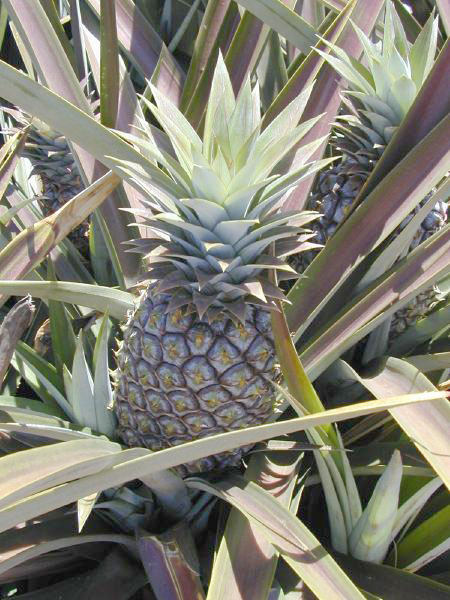- Ananas
Taxobox
name = "Ananas"

image_width = 250px
image_caption = Pineapple ("Ananas comosus")
regnum =Plant ae
divisio = Magnoliophyta
classis =Liliopsida
ordo =Poales
familia =Bromeliaceae
subfamilia =Bromelioideae
genus = "Ananas"
genus_authority = Mill.
subdivision_ranks = Species
subdivision = See text.The
genus "Ananas" pilli to the Bromeliad family (Bromeliaceae ). It is best known for the species "Ananas comosus", thepineapple .This genus originated in
Mesoamerica and was brought to theCaribbean Islands by theCarib natives. The oldest register with the representation of the fruit seems to be included in theCascajal Block , attributed to theOlmec civilization.In
1493 ,Christopher Columbus first saw plants of this genus inGuadeloupe . It was brought to Europe, and from there was distributed to the Pacific Islands by the Spanish and the English. Commercial pineapple plantations were established inHawaii , thePhilippines ,Southeast Asia ,Florida andCuba . The pineapple has become one of the world's most popular fruits.The tough leaves grow in large rosettes, arising basally from a crown. These leaves are long and lanceolate with a serrate or thorny margin. The
flower s, arising from the heart of the rosette, each have their ownsepal s. They grow into a compact head on a short, robust stalk. The sepals become fleshy and juicy and develop into the well-known complex form of the pseudocarp fruit, crowned by a rosette of leaves."Ananas" species are used as food plants by the
larva e of someLepidoptera species including "Batrachedra comosae", which feeds exclusively on "A. comosus".The word "Ananas" is derived from the
Guarani name for the pineapple, via Portuguese. In most Indo-European languages, pineapple is called "ananas".Chemistry
Pineapples contain both
bromelain andpapain to which it owes its meat tenderizing properties.Ethnomedical Use
The fruit and roots are used as
anti-inflammatory ,proteolytic agent, and a rootdecoction for diarrhea.Species and varieties
*"
Ananas ananassoides " var. "typicus"
*"Ananas arvensis " : (Brazil)
*"Ananas bracteatus " : (Brazil)
**"Ananas bracteatus" var. "albus"
**"Ananas bracteatus" var. "hondurensis"
**"Ananas bracteatus" var. "paraguariensis"
**"Ananas bracteatus" var. "rudis"
**"Ananas bracteatus" var. "striatus " (South America)
**"Ananas bracteatus" var. "tricolor"
**"Ananas bracteatus" var. "typicus"
*"Ananas comosus" (a.k.a. "Ananas sativus") -pineapple (Brazil)
*"Ananas erectifolius "
*"Ananas genesio-linesii " (Brazil)
*"Ananas guaraniticus " (Argentina, Paraguay)
*"Ananas macrodontes " (Brazil)
*"Ananas microcephalus " (tropical America)
**"Ananas microcephalus" var. "major" (South America)
**"Ananas microcephalus" var. "minor" (South America)
**"Ananas microcephalus" var. "missionensis" (Argentina)
**"Ananas microcephalus" var. "mondayanus " (South America)
**"Ananas microstachys" var. "typicus"
*"Ananas mordilona "
*"Ananas nanus "
*"Ananas pancheanus " (Colombia)
*"Ananas parguazensis " (South America)
*"Ananas pyramidalis "
*"Ananas strictus" (Paraguay)
*"Ananas viridis "
Wikimedia Foundation. 2010.
